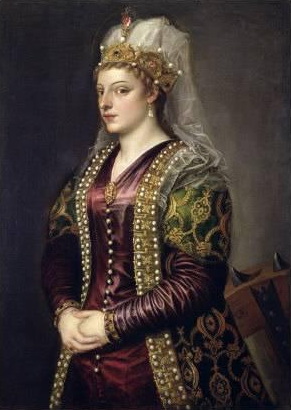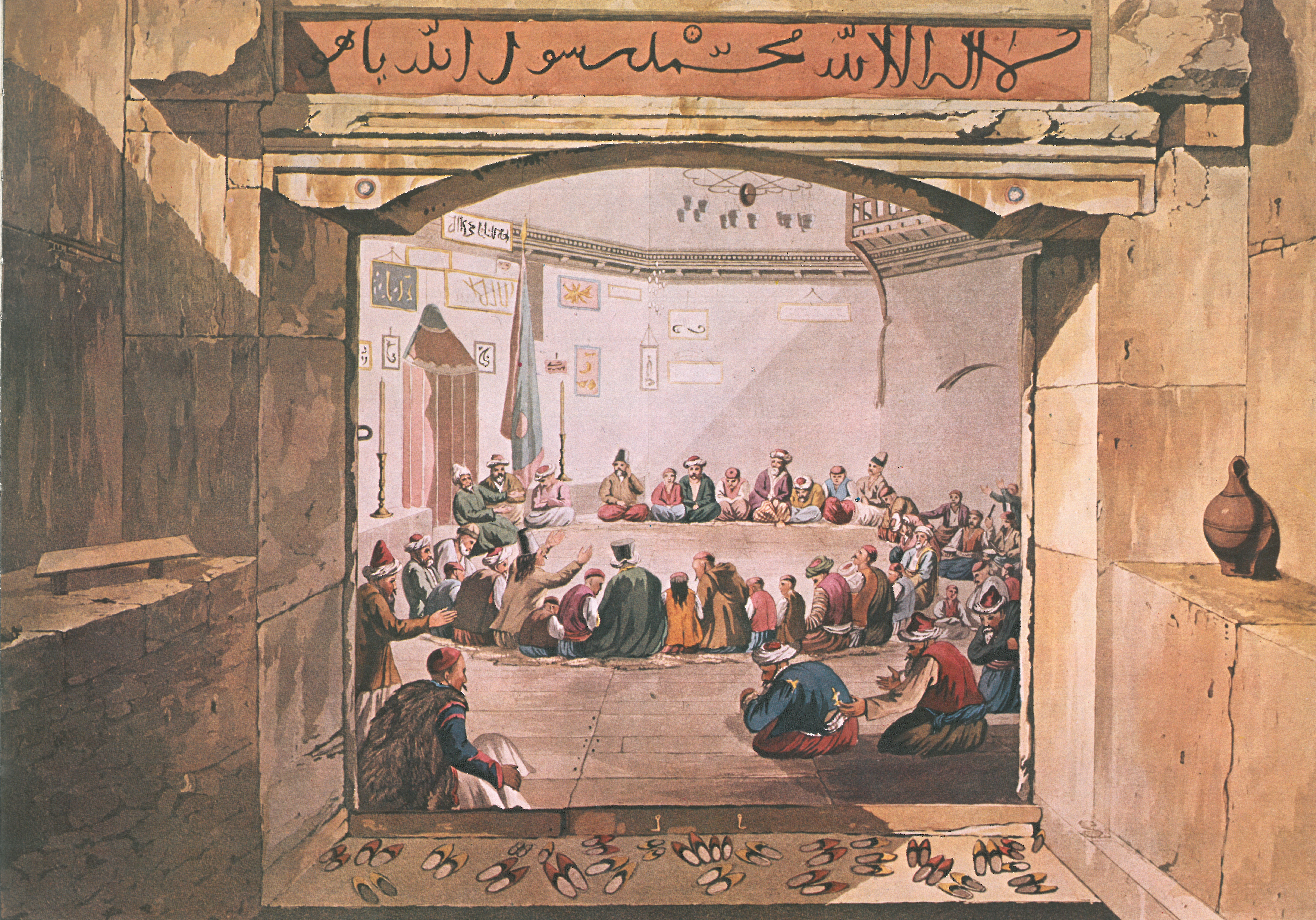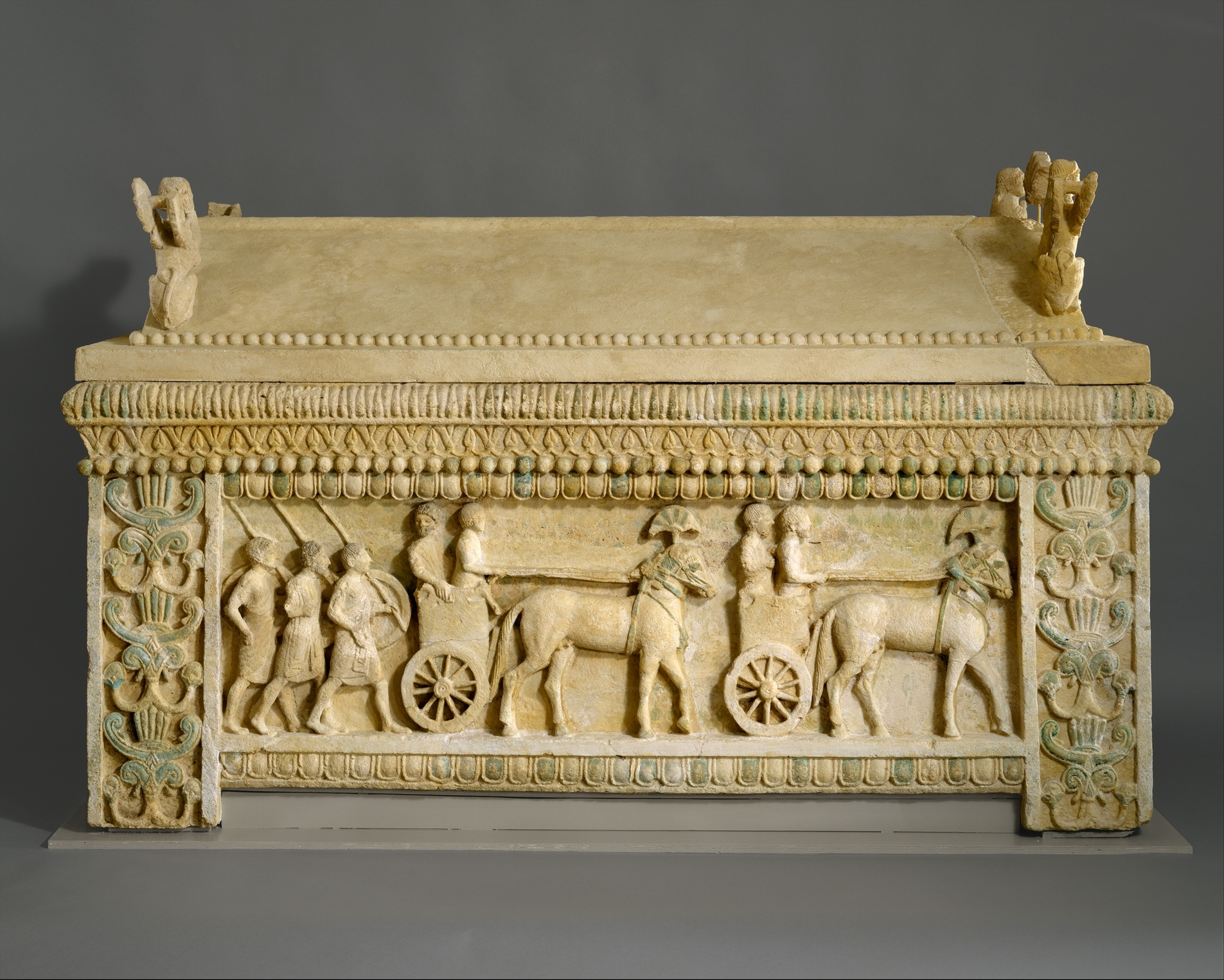|
Mevlevi Tekke Museum
Mevlevi Tekke Museum is a Khanqah, tekke in Nicosia, Cyprus, currently in North Nicosia. It has historically been used by the Mevlevi Order and now serves as a museum. It is one of the most important historical and religious buildings on the island. It is located next to the Kyrenia Gate, on Girne Avenue, in the İbrahimpaşa quarter. History Functioning as a tekke It is traditionally held that the building was built in the early 17th century, on a piece of land donated by a landlady called Emine Hatun. This Emine Hatun hailed from the village of Kyra, Cyprus, Kyra, where she owned a farm. It is rumoured by the locals that she is buried in a grave without any inscriptions, located to the northeast of the tomb in the tekke. According to another view, the tekke is located on land donated by Arab Ahmed Pasha and Haydar Paşazade Fatma Hanım. According to the Evkaf Administration, the tekke was initially built in 1593 by Arab Ahmed Pasha on a plot of land owned by him and then enla ... [...More Info...] [...Related Items...] OR: [Wikipedia] [Google] [Baidu] |
Rumi Museum - Northern Cyprus
Jalāl al-Dīn Muḥammad Rūmī (), or simply Rumi (30 September 1207 – 17 December 1273), was a 13th-century poet, Hanafi ''faqih'' (jurist), Maturidi Kalam, theologian (''mutakallim''), and Sufism, Sufi Mysticism, mystic born during the Khwarazmian Empire. Rumi's works were written mostly in Persian language, Persian, but occasionally he also used Old Anatolian Turkish, Turkish, Arabic and Cappadocian Greek, Greek in his verse. His ''Masnavi'' (''Mathnawi''), composed in Konya, is considered one of the greatest poems of the Persian language.C.E. Bosworth, "Turkmen Expansion towards the west" in UNESCO History of Humanity, Volume IV, titled "From the Seventh to the Sixteenth Century", UNESCO Publishing / Routledge, p. 391: "While the Arabic language retained its primacy in such spheres as law, theology and science, the culture of the Seljuk court and secular literature within the sultanate became largely Persianized; this is seen in the early adoption of Persian epic ... [...More Info...] [...Related Items...] OR: [Wikipedia] [Google] [Baidu] |
Mehmet Bey Ebubekir Tekke
Mehmed or Mehmet is the most common Turkish form of the Arabic male name Muhammad () (''Muhammed'' and ''Muhammet'' are also used, though considerably less) and gains its significance from being the name of Muhammad, the prophet of Islam. Originally the intermediary vowels in the Arabic ''Muhammad'' were completed with an ''e'' in adaptation to Turkish phonotactics, which spelled Mehemmed, Mehemed and the name lost the central ''e'' over time. Final devoicing of ''d'' to ''t'' is a regular process in Turkish. The prophet himself is referred to in Turkish using the archaic version, ''Muhammed''. In Azerbaijani it is ''Məhəmməd''. The name Mehmet also often appears in derived compound names. The name is also prevalent in former Ottoman territories, particularly among Balkan Muslims in Albania, Bosnia and Kosovo. The name is also commonly used in Turkish culture in the form of Mehmetçik, meaning ''little Mehmet'', for unranked soldiers. Given name Mehmed *Mehmed I (1382–1 ... [...More Info...] [...Related Items...] OR: [Wikipedia] [Google] [Baidu] |
Venetian Cyprus
The island of Cyprus was a overseas possession of the Venetian from 1489, when the independent Kingdom of Cyprus ended, until 1571, when the island was conquered by the Ottoman. History Acquisition Venice had sought control of Cyprus for centuries, and Venetian merchants were active on the island beginning around 1000 AD, when Venetian commercial and military expansion in the eastern Mediterranean began. In 1468, James II of Cyprus of the House of Lusignan became King of Cyprus. In 1468, he chose Catherine Cornaro (born in Venice from the noble Corner family) as his wife and Queen consort of Cyprus. This choice greatly pleased the Republic of Venice, as it could henceforth secure Venice's commercial rights and other privileges in Cyprus. They married by proxy in Venice on July 30, 1468, when she was 14 years old. James died shortly after the wedding from a sudden illness, and, according to his will, Caterina, who was pregnant at the time, acted as regent. She became mon ... [...More Info...] [...Related Items...] OR: [Wikipedia] [Google] [Baidu] |
Dervish
Dervish, Darvesh, or Darwīsh (from ) in Islam can refer broadly to members of a Sufi fraternity (''tariqah''), or more narrowly to a religious mendicant, who chose or accepted material poverty. The latter usage is found particularly in Persian and Turkish (''derviş'') as well as in Tamazight (''Aderwic''), corresponding to the Arabic term '' faqīr''. Their focus is on the universal values of love and service, deserting the illusions of ego (''nafs'') to reach God. In most Sufi orders, a dervish is known to practice ''dhikr'' through physical exertions or religious practices to attain the ecstatic trance to reach God. Their most popular practice is Sama, which is associated with the 13th-century mystic Rumi. In folklore and with adherents of Sufism, dervishes are often credited with the ability to perform miracles and ascribed supernatural powers. Historically, the term Dervish has also been used more loosely, as the designation of various Islamic political movements or mil ... [...More Info...] [...Related Items...] OR: [Wikipedia] [Google] [Baidu] |
Sama (Sufism)
Sama (; ) is a Sufi ceremony performed as part of the meditation and prayer practice dhikr. Sama means "listening", while dhikr means "remembrance".During, J., and R. Sellheim. "Sama" Encyclopedia of Islam, Second Edition. Ed. P. Bearman, T. Bianquis, C. E. Bosworth, E. Van Donzel and W. P. Heinrichs. Brill Online, 2010. These performances often include singing, playing instruments, dancing, recitation of poetry and prayers, wearing symbolic attire, and other rituals. Sama is a particularly popular form of worship in Sufism. In 2005, UNESCO confirmed the "Mevlevi Sama Ceremony" of Turkey as one of the Masterpieces of the Oral and Intangible Heritage of Humanity. Etymology The term sama stems from the root-verb meaning ''acceptance by tradition'', from which are derived the words سَمْع (''sam‘un'') and اِسْتِمَاع (''’istimā‘un'', listening), often paired with نَقْل (''naqlun'') and تَقْلِيد (''taqlīdun'', tradition). It may have been in use ... [...More Info...] [...Related Items...] OR: [Wikipedia] [Google] [Baidu] |
Marmara University
Marmara University (Turkish language, Turkish: ''Marmara Üniversitesi'') is a Public university, public research university in Istanbul, Turkey. The university, named after the Sea of Marmara, was founded as a university in 1982. However, its origins date back to 1883, when it was established as ''Hamidiye Ticaret Mekteb-i Âlisi'' in a house in central Istanbul. The university offers courses in five languages: Turkish language, Turkish, English language, English, German language, German, French language, French, and Arabic, making it the only multilingual university in Turkey. It operates 13 campuses, 11 institutes, 8 colleges, and 28 research centers. Prominent alumni include Turkish President Recep Tayyip Erdoğan, comic actor Kemal Sunal, and former media mogul Aydın Doğan. Organisation Marmara University has several campuses in Istanbul and offers education in five languages: Turkish language, Turkish, English language, English, German language, German, French language, ... [...More Info...] [...Related Items...] OR: [Wikipedia] [Google] [Baidu] |
Ottoman Architecture
Ottoman architecture is an architectural style or tradition that developed under the Ottoman Empire over a long period, undergoing some significant changes during its history. It first emerged in northwestern Anatolia in the late 13th century and developed from earlier Anatolian Seljuk architecture, Seljuk Turkish architecture, with influences from Byzantine architecture, Byzantine and Iranian architecture, Iranian architecture along with other architectural traditions in the Middle East. Early Ottoman architecture experimented with multiple building types over the course of the 13th to 15th centuries, progressively evolving into the Classical Ottoman architecture, classical Ottoman style of the 16th and 17th centuries. This style was a mixture of native Turkish tradition and influences from the Hagia Sophia, resulting in monumental mosque buildings focused around a high central dome with a varying number of semi-domes. The most important architect of the classical period is Mimar ... [...More Info...] [...Related Items...] OR: [Wikipedia] [Google] [Baidu] |
Damascus
Damascus ( , ; ) is the capital and List of largest cities in the Levant region by population, largest city of Syria. It is the oldest capital in the world and, according to some, the fourth Holiest sites in Islam, holiest city in Islam. Known colloquially in Syria as () and dubbed, poetically, the "City of Jasmine" ( ), Damascus is a major cultural center of the Levant and the Arab world. Situated in southwestern Syria, Damascus is the center of a large metropolitan area. Nestled among the eastern foothills of the Anti-Lebanon mountain range inland from the eastern shore of the Mediterranean on a plateau above sea level, Damascus experiences an arid climate because of the rain shadow effect. The Barada, Barada River flows through Damascus. Damascus is one of the List of oldest continuously inhabited cities, oldest continuously inhabited cities in the world. First settled in the 3rd millennium BC, it was chosen as the capital of the Umayyad Caliphate from 661 to 750. Afte ... [...More Info...] [...Related Items...] OR: [Wikipedia] [Google] [Baidu] |
Aleppo
Aleppo is a city in Syria, which serves as the capital of the Aleppo Governorate, the most populous Governorates of Syria, governorate of Syria. With an estimated population of 2,098,000 residents it is Syria's largest city by urban area, and was the largest by population until it was surpassed by Damascus, the capital of Syria. Aleppo is also the largest city in Syria's Governorates of Syria, northern governorates and one of the List of largest cities in the Levant region by population, largest cities in the Levant region. Aleppo is one of List of cities by time of continuous habitation#West Asia, the oldest continuously inhabited cities in the world; it may have been inhabited since the sixth millennium BC. Excavations at Tell as-Sawda and Tell al-Ansari, just south of the old city of Aleppo, show that the area was occupied by Amorites by the latter part of the third millennium BC. That is also the time at which Aleppo is first mentioned in cuneiform tablets unearthed in Ebl ... [...More Info...] [...Related Items...] OR: [Wikipedia] [Google] [Baidu] |
Atatürk's Reforms
Atatürk's reforms ( or ''Atatürk Devrimleri''), also referred to as the Turkish Revolution (Turkish language, Turkish: ''Türk Devrimi''), were a series of political, legal, religious, cultural, social, and economic policy changes, designed to transform the new Turkey, Republic of Turkey into a Secularism in Turkey, secular, modern Nation state, nation-state, implemented under the leadership of Mustafa Kemal Atatürk in accordance with the Kemalism, Kemalist framework. The principal political entity, the Republican People's Party (CHP), ruled One-party period of the Republic of Turkey, Turkey as a one-party state from 1923 to 1945, with several exceptions of attempts for a multi-party democracy. Death and state funeral of Mustafa Kemal Atatürk, Following Atatürk's death in 1938, his successor İsmet İnönü took over the leadership and integrated further Kemalist reforms. İnönü's work was however stranded by World War II and the CHP eventually 1950 Turkish general elect ... [...More Info...] [...Related Items...] OR: [Wikipedia] [Google] [Baidu] |
Limassol
Limassol, also known as Lemesos, is a city on the southern coast of Cyprus and capital of the Limassol district. Limassol is the second-largest urban area in Cyprus after Nicosia, with an urban population of 195,139 and a district population of 262,238. The Limassol municipality is the most populated in Cyprus, with a population of 108,105, followed by Strovolos in Nicosia. Limassol was built between two ancient Greek cities, Amathus and Kourion. Its historical centre is located around the medieval Limassol Castle and the Old Port. Today the city spreads along the Mediterranean coast and has extended much farther than the castle and port, with its suburbs stretching along the coast to Amathus. To the west of the city is Akrotiri, one of the two British Overseas Territories of Akrotiri and Dhekelia on the island. In 2014, Limassol was ranked by TripAdvisor as the 3rd up-and-coming destination in the world, in its Top 10 Traveler's Choice Destinations on the Rise list. In ... [...More Info...] [...Related Items...] OR: [Wikipedia] [Google] [Baidu] |
Piri Osman Tekke
Sophie Leigh McBurnie (born 14 March 1999), known professionally as Piri, is an English musician. Born in Rochdale, she is half of the band Piri & Tommy and an original member of the female and genderqueer collective Loud LDN. Three of her works as half of Piri & Tommy have entered the UK charts: their 2021 single " Soft Spot" reached No. 20 on the UK Independent Singles Breakers Chart, their 2022 single " On & On" went to No. 99 on the UK Singles Chart, and their 2022 mixtape '' Froge.mp3'' made No. 13 on the UK Dance Albums Chart. "Soft Spot" was ranked No. 59 on ''Rolling Stone''s "200 Greatest Dance Songs of All Time" in July 2022, while their 2022 works "Words", "On & On", and ''Froge.mp3'', and their cover of Charli XCX and Kim Petras's "Unlock It" all appeared on year-end best-of lists. In addition, she co-wrote the Illit song "Magnetic", which charted at No. 80 on the UK Singles Chart, and has been named as an influence by Caity Baser. Life and career 1999–2020: E ... [...More Info...] [...Related Items...] OR: [Wikipedia] [Google] [Baidu] |








